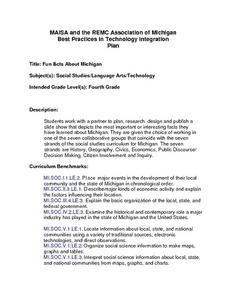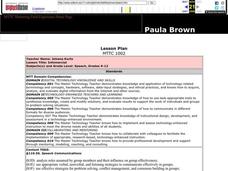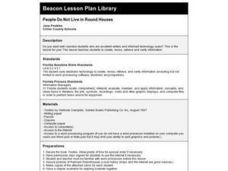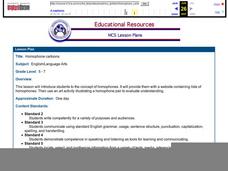Curated OER
Birthday Buddy
Students explore an Internet web site and/or the Groliers Encyclopedia to investigate a famous person who shares their birthday. They write a five paragraph comparison and contrast essay on their findings and utilize ClarisWorks to publish.
Curated OER
Turtle Sightings
Third graders research turtles and the ways they have adapted to their marine environment. They work in groups and publish their findings using SiteMaker a web-authoring tool.
Curated OER
Creative Writing with Images
Students take digital pictures and write creative stories around them in an electronic storybook. Using WebBlender, they publish their final project as a Website. They also present their stories to students, parents, and community members.
Curated OER
Mail Bonding
Students explore different forms of communication via the Internet and the effects these electronic mediums have on social relationships. They compose e-mail messages and predict the gender of authors of anonymous e-mail messages of...
Curated OER
Michigan Fun Facts
Fourth graders work with a partner to plan, rese,a rch design and publish a
slide show that depicts the most important or interesting facts they
have learned about Michigan. They are given the choice of working in
one of the seven...
Curated OER
Discovering Unusual Facts about U.S. Presidents
Students research information on the Internet about past presidents. They verify answers using an encyclopedia and generate a report regarding the accuracy of electronic information sources.
Curated OER
Creating Storyboards for Younger Students
Students create electronic storyboards for younger children about a nearby refuge and lake. After interviewing the younger students about their impressions of the lake, they use Powerpoint to make the storyboard, including the interview,...
Curated OER
Rock On
Fourth graders create a powerpint presentation to inform their classmates about a selected type of rock. Students are divided into groups to research a particular type of rock. Each group researches their topic using traditional and...
Curated OER
Infomercial
High schoolers use the Internet to research a topic for an infomercial presentation. Using the research gathered, students design the layout of a brochure. Next, high schoolers use Microsoft Publisher to create a brochure that combines...
Curated OER
CEENBot Soccer
Students research the history and uses of the different elements in the periodic table. In this chemistry instructional activity, students explain the significance of an element's valence electrons. They create a multimedia presentation...
Curated OER
People Do Not Live in Round Houses
Third graders use a computer as a research tool. They make note cards as they go and use their note cards to guide their word processing. They edit their papers and add artwork.
Baylor College
Crossing the Synaptic Gap
As part of a unit on the chemistry of the brain, thinkers learn how chemicals work to transmit messages between individual neurons and how controlled substances impact the synaptic cleft. They do so by playing a dice-and-card game in...
Baylor College
What Is a Neuron?
Your class won't get on your nerves while doing this modeling activity! After teaching the structure and function of a neuron using the included diagrams, give individuals some clay and chenille stems so that they can make their own...
Baylor College
Pre-Assessment: The Brain
Break your class in to the general structure and function of the brain. Brainiacs discuss what they know about it and create personalized brain development timelines. They also take a true-false, pre-assessment quiz to get them thinking...
Baylor College
Neurotransmitters Contain Chemicals
Human body systems young scholars play a card game, "Locks & Keys" in order to learn that neurotransmitters carry a message from one neuron to another by fitting into a receptor site on the receiving nerve cell. While this activity...
Baylor College
Drugs, Risks and the Nervous System
In cooperative groups, middle schoolers contemplate the probability of 18 different situations occurring. After they make predictions, they compare them to the actual risk factors. This eye-opening exercise demonstrates that the odds of...
Baylor College
Neural Network Signals
Using a simple circuit with the battery representing the brain, future physiologists test to see which solutions conduct electrical "nerve impulses." Enlighten learners with plentiful information on electric signals in the nervous system...
Curated OER
Homophone Cartoons
A terrific lesson on homophones awaits your youngsters. First, pupils access a website that contains lists of homophones. Then, it's time to get creative! Everyone gets a piece of poster board and they create a homophone cartoon -...
Curated OER
Animals Galore
A well-designed lesson which covers the characteristics of the animals found in the six animal groups is here for your young biologists. In it, learners divide up into six groups; the amphibians, reptiles, mammals, birds, fish, and...
Baylor College
Food Webs
Explore various ecosystems from around the world as your class discovers the interdependence of all living things. Using the provided sets of ecosystem cards, young scientists work in small groups building food webs to demonstrate the...
Baylor College
Using Heat from the Sun
Let's heat things up! This simple experiment demonstrates for young scholars the important role the sun plays in providing the earth with energy. Place one cup of water in direct sunlight and one in shade, then take measurements in order...
Baylor College
Rainbow in the Room
Uncover the science behind the beautiful phenomena of rainbows with a simple demonstration. Shine light through different-sized containers of water as young scientists learn that rainbows occur when visible light is split up into its...
Baylor College
Fossil Fuels and the Carbon Cycle
Humans are quickly depleting Earth's fossil fuels and locating them is becoming increasingly difficult! Layered muffins are used for models as young geologists take core samples in order to determine the presence of oil. Consider first...
Baylor College
Modeling Earth's Atmosphere
Life on Earth is made possible by the unique composition of its atmosphere. Working collaboratively, a scale model is created as young scientists learn about the different layers of gas that surround the planet. Cards are included that...























